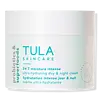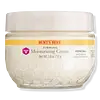What's inside
What's inside
 Key Ingredients
Key Ingredients

 Benefits
Benefits

 Concerns
Concerns

 Ingredients Side-by-side
Ingredients Side-by-side

Water
Skin ConditioningButyrospermum Parkii Butter
Skin ConditioningPropanediol
SolventGlycerin
HumectantDicaprylyl Carbonate
EmollientJojoba Esters
EmollientCamellia Japonica Seed Oil
EmollientLactococcus Ferment Lysate
Skin ConditioningGlyceryl Stearate
EmollientCetearyl Alcohol
EmollientAmmonium Acryloyldimethyltaurate/Beheneth-25 Methacrylate Crosspolymer
Emulsion StabilisingMyristyl Myristate
EmollientSqualane
EmollientPolyacrylate Crosspolymer-6
Emulsion StabilisingHyaluronic Acid
HumectantCollagen
MoisturisingHippophae Rhamnoides Oil
EmollientArgania Spinosa Kernel Oil
EmollientLinoleic Acid
CleansingLinolenic Acid
CleansingHydrolyzed Rice Protein
Skin ConditioningLactobacillus
Skin ConditioningLactobacillus Ferment
Skin ConditioningCichorium Intybus Root Extract
MaskingCitrullus Lanatus Fruit Extract
Skin ConditioningPyrus Malus Fruit Extract
Skin ConditioningCurcuma Longa Root Extract
MaskingLactic Acid
BufferingVaccinium Angustifolium Fruit Extract
Skin ProtectingBeta Vulgaris Root Extract
Skin ConditioningTocopheryl Acetate
AntioxidantInulin
Skin ConditioningPolymnia Sonchifolia Root Juice
Skin ConditioningAlpha-Glucan Oligosaccharide
CleansingAscorbyl Palmitate
AntioxidantLens Esculenta Fruit Extract
Skin ConditioningSodium PCA
HumectantLeuconostoc/Radish Root Ferment Filtrate
AntimicrobialButylene Glycol
HumectantCandelilla/Jojoba/Rice Bran Polyglyceryl-3 Esters
EmulsifyingCaprylyl Glycol
EmollientCetearyl Olivate
Maltodextrin
AbsorbentPentylene Glycol
Skin ConditioningPotassium Sorbate
PreservativeSodium Benzoate
MaskingSodium Chloride
MaskingSodium Phytate
Polysorbate 60
EmulsifyingSodium Stearoyl Lactylate
EmulsifyingParfum
MaskingWater, Butyrospermum Parkii Butter, Propanediol, Glycerin, Dicaprylyl Carbonate, Jojoba Esters, Camellia Japonica Seed Oil, Lactococcus Ferment Lysate, Glyceryl Stearate, Cetearyl Alcohol, Ammonium Acryloyldimethyltaurate/Beheneth-25 Methacrylate Crosspolymer, Myristyl Myristate, Squalane, Polyacrylate Crosspolymer-6, Hyaluronic Acid, Collagen, Hippophae Rhamnoides Oil, Argania Spinosa Kernel Oil, Linoleic Acid, Linolenic Acid, Hydrolyzed Rice Protein, Lactobacillus, Lactobacillus Ferment, Cichorium Intybus Root Extract, Citrullus Lanatus Fruit Extract, Pyrus Malus Fruit Extract, Curcuma Longa Root Extract, Lactic Acid, Vaccinium Angustifolium Fruit Extract, Beta Vulgaris Root Extract, Tocopheryl Acetate, Inulin, Polymnia Sonchifolia Root Juice, Alpha-Glucan Oligosaccharide, Ascorbyl Palmitate, Lens Esculenta Fruit Extract, Sodium PCA, Leuconostoc/Radish Root Ferment Filtrate, Butylene Glycol, Candelilla/Jojoba/Rice Bran Polyglyceryl-3 Esters, Caprylyl Glycol, Cetearyl Olivate, Maltodextrin, Pentylene Glycol, Potassium Sorbate, Sodium Benzoate, Sodium Chloride, Sodium Phytate, Polysorbate 60, Sodium Stearoyl Lactylate, Parfum
Water
Skin ConditioningDecyl Cocoate
EmollientHelianthus Annuus Seed Oil
EmollientGlycerin
HumectantCaprylic/Capric Triglyceride
MaskingCetyl Alcohol
EmollientBakuchiol
AntimicrobialBeeswax
Emulsion StabilisingGlyceryl Stearate Citrate
EmollientStearic Acid
CleansingStearyl Alcohol
EmollientZea Mays Starch
AbsorbentTocopherol
AntioxidantGlycine Soja Oil
EmollientCetearyl Alcohol
EmollientCoco-Glucoside
CleansingMagnesium Aluminum Silicate
AbsorbentXanthan Gum
EmulsifyingSodium Stearoyl Lactylate
EmulsifyingArginine
MaskingSclerotium Gum
Emulsion StabilisingParfum
MaskingPhenoxyethanol
PreservativeEugenol
PerfumingGeraniol
PerfumingLimonene
PerfumingLinalool
PerfumingWater, Decyl Cocoate, Helianthus Annuus Seed Oil, Glycerin, Caprylic/Capric Triglyceride, Cetyl Alcohol, Bakuchiol, Beeswax, Glyceryl Stearate Citrate, Stearic Acid, Stearyl Alcohol, Zea Mays Starch, Tocopherol, Glycine Soja Oil, Cetearyl Alcohol, Coco-Glucoside, Magnesium Aluminum Silicate, Xanthan Gum, Sodium Stearoyl Lactylate, Arginine, Sclerotium Gum, Parfum, Phenoxyethanol, Eugenol, Geraniol, Limonene, Linalool
 Reviews
Reviews

Ingredients Explained
These ingredients are found in both products.
Ingredients higher up in an ingredient list are typically present in a larger amount.
Cetearyl alcohol is a mixture of two fatty alcohols: cetyl alcohol and stearyl alcohol. It is mainly used as an emulsifier. Emulsifiers help prevent the separation of oils and products. Due to its composition, it can also be used to thicken a product or help create foam.
Cetearyl alcohol is an emollient. Emollients help soothe and hydrate the skin by trapping moisture.
Studies show Cetearyl alcohol is non-toxic and non-irritating. The FDA allows products labeled "alcohol-free" to have fatty alcohols.
This ingredient is usually derived from plant oils such as palm, vegetable, or coconut oils. There is debate on whether this ingredient will cause acne.
Due to the fatty acid base, this ingredient may not be Malassezia folliculitis safe.
Learn more about Cetearyl AlcoholGlycerin is already naturally found in your skin. It helps moisturize and protect your skin.
A study from 2016 found glycerin to be more effective as a humectant than AHAs and hyaluronic acid.
As a humectant, it helps the skin stay hydrated by pulling moisture to your skin. The low molecular weight of glycerin allows it to pull moisture into the deeper layers of your skin.
Hydrated skin improves your skin barrier; Your skin barrier helps protect against irritants and bacteria.
Glycerin has also been found to have antimicrobial and antiviral properties. Due to these properties, glycerin is often used in wound and burn treatments.
In cosmetics, glycerin is usually derived from plants such as soybean or palm. However, it can also be sourced from animals, such as tallow or animal fat.
This ingredient is organic, colorless, odorless, and non-toxic.
Glycerin is the name for this ingredient in American English. British English uses Glycerol/Glycerine.
Learn more about GlycerinParfum is a catch-all term for an ingredient or more that is used to give a scent to products.
Also called "fragrance", this ingredient can be a blend of hundreds of chemicals or plant oils. This means every product with "fragrance" or "parfum" in the ingredients list is a different mixture.
For instance, Habanolide is a proprietary trade name for a specific aroma chemical. When used as a fragrance ingredient in cosmetics, most aroma chemicals fall under the broad labeling category of “FRAGRANCE” or “PARFUM” according to EU and US regulations.
The term 'parfum' or 'fragrance' is not regulated in many countries. In many cases, it is up to the brand to define this term.
For instance, many brands choose to label themselves as "fragrance-free" because they are not using synthetic fragrances. However, their products may still contain ingredients such as essential oils that are considered a fragrance by INCI standards.
One example is Calendula flower extract. Calendula is an essential oil that still imparts a scent or 'fragrance'.
Depending on the blend, the ingredients in the mixture can cause allergies and sensitivities on the skin. Some ingredients that are known EU allergens include linalool and citronellol.
Parfum can also be used to mask or cover an unpleasant scent.
The bottom line is: not all fragrances/parfum/ingredients are created equally. If you are worried about fragrances, we recommend taking a closer look at an ingredient. And of course, we always recommend speaking with a professional.
Learn more about ParfumThis ingredient also goes by the name SSL. It is a non-toxic, biodegradable ingredient made from renewable sources.
SSL is typically used as a surfactant and emulsifier in skincare to stabilize water-based formulas and improve texture. It can be synthetic or animal-derived.
Water. It's the most common cosmetic ingredient of all. You'll usually see it at the top of ingredient lists, meaning that it makes up the largest part of the product.
So why is it so popular? Water most often acts as a solvent - this means that it helps dissolve other ingredients into the formulation.
You'll also recognize water as that liquid we all need to stay alive. If you see this, drink a glass of water. Stay hydrated!
Learn more about Water